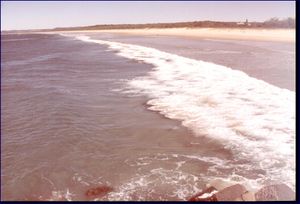Difference between revisions of "Coastal zone characteristics"
From Coastal Wiki
| Line 24: | Line 24: | ||
===Barrier coasts=== | ===Barrier coasts=== | ||
| + | [[Image:barrier.jpg|thumb|barrier coast]] | ||
*barrier islands are parallel to the shore, separated from mainland by a lagoon | *barrier islands are parallel to the shore, separated from mainland by a lagoon | ||
*in a profile with a more gentle slope than the equilibrium profile, sediments will be moved onshore, as waves on the shoreface will primarily transport sand towards shore attempting to build up equilibrium profile. Waves lose their energy over the gentle shoreface and deposition occurs some distance from shoreline | *in a profile with a more gentle slope than the equilibrium profile, sediments will be moved onshore, as waves on the shoreface will primarily transport sand towards shore attempting to build up equilibrium profile. Waves lose their energy over the gentle shoreface and deposition occurs some distance from shoreline | ||
Revision as of 11:15, 11 January 2007
This one should be relatively short - with links to more specific entries.
Contents
Land-sea interaction
Dynamic (or ever changing) environment
Different coastal types:
Sandy beaches
Natural sandy beaches :
- Their appearance is determined by hydrographic conditions and geology
- Any interference will cause a reaction in the form of a shoreline response
Therefore:
- Understanding of physical processes is important
- Development of suitable solutions required, supported by numerical modelling if needed
- sand is a very common marine sediment and is transported along the shoreline by littoral transport
- sand transport (littoral transport or littoral drift) is driven by the breaking waves and the longshore currents in the wave breaking zone
Barrier coasts
- barrier islands are parallel to the shore, separated from mainland by a lagoon
- in a profile with a more gentle slope than the equilibrium profile, sediments will be moved onshore, as waves on the shoreface will primarily transport sand towards shore attempting to build up equilibrium profile. Waves lose their energy over the gentle shoreface and deposition occurs some distance from shoreline
- eventually develops into a barrier island (cross-shore transport)
- transport of sand by longshore transport will add to barrier formation, a combination of sand spit and barrier island processes, normally occurring under type 1 and 2 conditions
Muddy coasts
- are only found in environments that are fairly calm with respect to wave conditions; or there is abundant supply of fine sediments
- normally vegetated e.g. mangroves fronted by very flat slopes or tidal flats
- a muddy coast with mangrove vegetation is characterized by a muddy shoreface, sometimes in the form of muddy tidal flats, and the lack of a sandy shore
- the area exposed to tidal variation is often vegetated by mangrove
- this coast type occurs in tropical climates where rivers supply abundant fine material to coastal zone (CZ)
- wave exposure is normally low to moderate; tidal regime can be any
- connected coast type is often low wetland exposed to flooding
- mangrove constitutes an important part of muddy coast profile, biologically and for stability. Cutting can cause severe problems, decreasing biodiversity and causing erosion and flooding. (p68)
- mixed environments with wave-exposed shores or sandy tidal flats alternating with mud-dominated tidal flats and deeper muddy areas are seen often (and require special management consideration) (p 55-56)
- Silt and clay are not stable in the littoral zone and are washed offshore. If large amounts of fines are supplied, mud flats and mangrove areas may develop (ppt)

